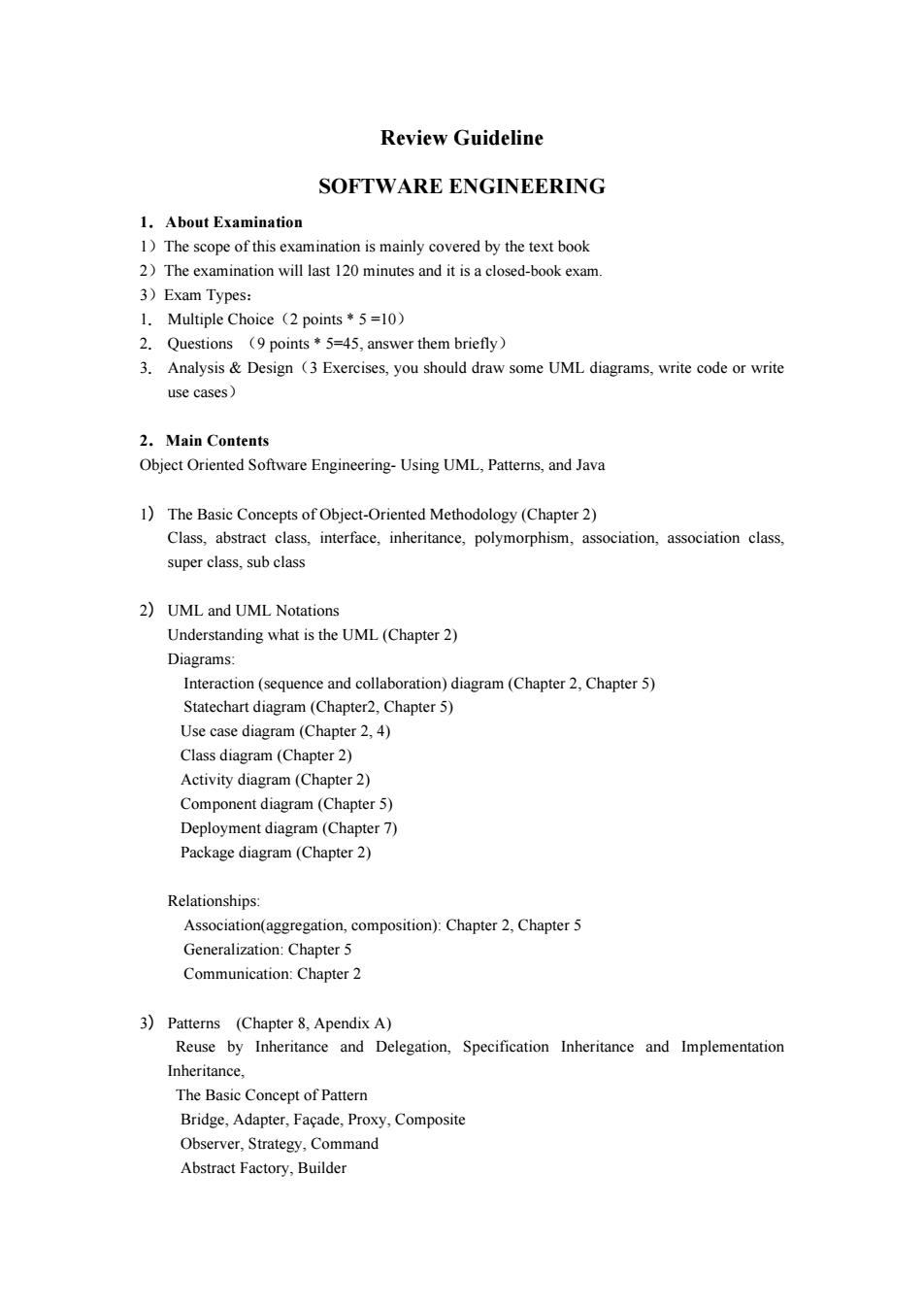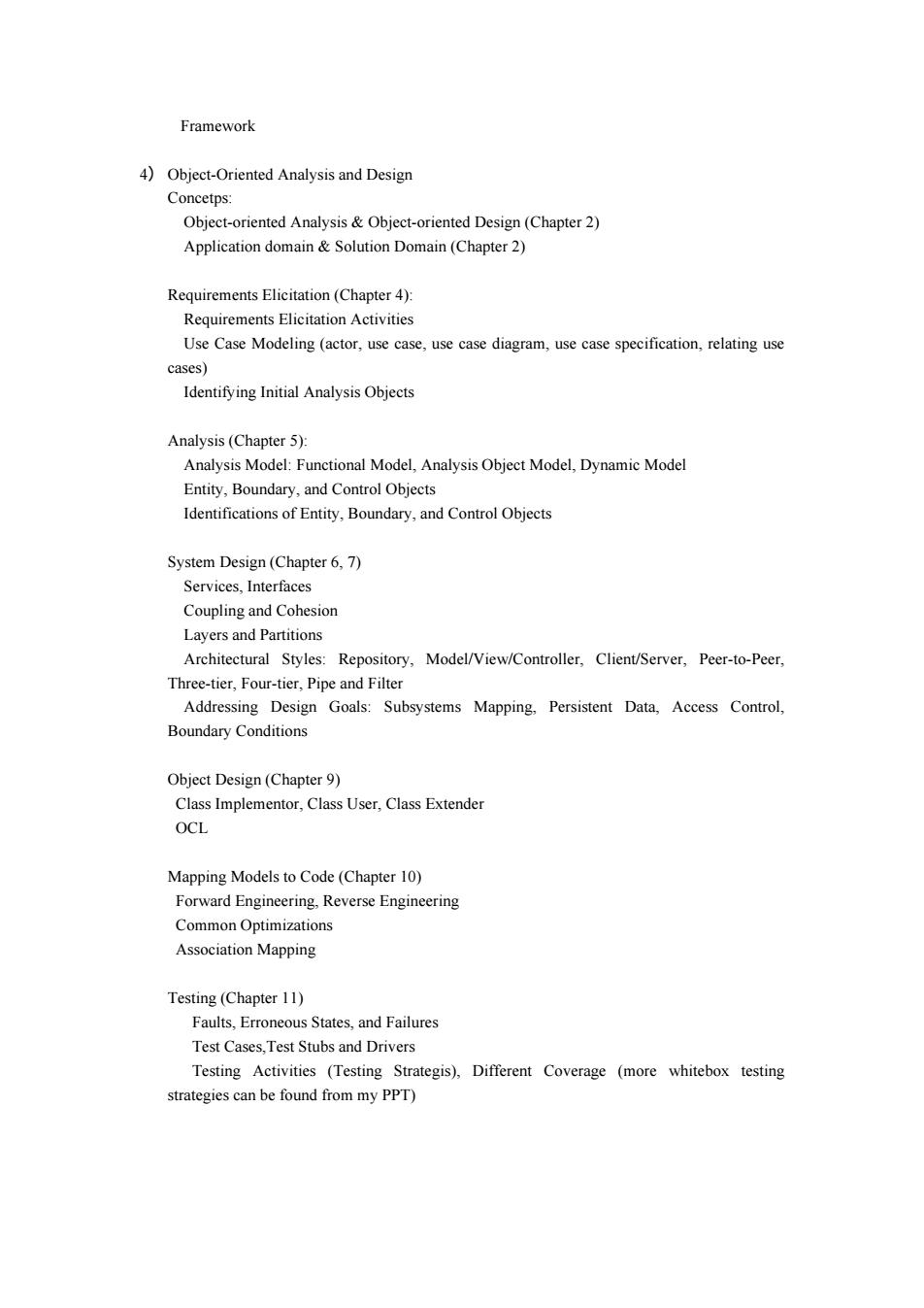
Review Guideline SOFTWARE ENGINEERING 1.About Examination 1)The scope of this examination is mainly covered by the text book 2)The examination will last 120 minutes and it is a closed-book exam. 3)Exam Types: 1.Multiple Choice (2 points 5=10) 2.Questions (9 points 5=45,answer them briefly) 3.Analysis Design (3 Exercises,you should draw some UML diagrams,write code or write use cases 2.Main Contents Object Oriented Software Engineering-Using UML,Patterns,and Java 1)The Basic Concepts of Object-Oriented Methodology(Chapter 2) Class,abstract class,interface,inheritance,polymorphism,association,association class, super class,sub class 2)UML and UML Notations Understanding what is the UML (Chapter 2) Diagrams: Interaction(sequence and collaboration)diagram(Chapter 2,Chapter 5) Statechart diagram(Chapter2,Chapter 5) Use case diagram(Chapter 2,4) Class diagram(Chapter 2) Activity diagram (Chapter 2) Component diagram(Chapter 5) Deployment diagram(Chapter 7) Package diagram(Chapter 2) Relationships: Association(aggregation,composition):Chapter 2,Chapter 5 Generalization:Chapter 5 Communication:Chapter 2 3)Patterns (Chapter 8,Apendix A) Reuse by Inheritance and Delegation,Specification Inheritance and Implementation Inheritance, The Basic Concept of Pattern Bridge,Adapter,Facade,Proxy,Composite Observer,Strategy,Command Abstract Factory,Builder
Review Guideline SOFTWARE ENGINEERING 1.About Examination 1)The scope of this examination is mainly covered by the text book 2)The examination will last 120 minutes and it is a closed-book exam. 3)Exam Types: 1. Multiple Choice(2 points * 5 =10) 2. Questions (9 points * 5=45, answer them briefly) 3. Analysis & Design(3 Exercises, you should draw some UML diagrams, write code or write use cases) 2.Main Contents Object Oriented Software Engineering- Using UML, Patterns, and Java 1) The Basic Concepts of Object-Oriented Methodology (Chapter 2) Class, abstract class, interface, inheritance, polymorphism, association, association class, super class, sub class 2) UML and UML Notations Understanding what is the UML (Chapter 2) Diagrams: Interaction (sequence and collaboration) diagram (Chapter 2, Chapter 5) Statechart diagram (Chapter2, Chapter 5) Use case diagram (Chapter 2, 4) Class diagram (Chapter 2) Activity diagram (Chapter 2) Component diagram (Chapter 5) Deployment diagram (Chapter 7) Package diagram (Chapter 2) Relationships: Association(aggregation, composition): Chapter 2, Chapter 5 Generalization: Chapter 5 Communication: Chapter 2 3) Patterns (Chapter 8, Apendix A) Reuse by Inheritance and Delegation, Specification Inheritance and Implementation Inheritance, The Basic Concept of Pattern Bridge, Adapter, Façade, Proxy, Composite Observer, Strategy, Command Abstract Factory, Builder

Framework 4)Object-Oriented Analysis and Design Concetps: Object-oriented Analysis Object-oriented Design(Chapter 2) Application domain Solution Domain(Chapter 2) Requirements Elicitation (Chapter 4): Requirements Elicitation Activities Use Case Modeling (actor,use case,use case diagram,use case specification,relating use cases) Identifying Initial Analysis Objects Analysis (Chapter 5): Analysis Model:Functional Model,Analysis Object Model,Dynamic Model Entity,Boundary,and Control Objects Identifications of Entity,Boundary,and Control Objects System Design (Chapter 6,7) Services,Interfaces Coupling and Cohesion Layers and Partitions Architectural Styles:Repository,Model/View/Controller,Client/Server,Peer-to-Peer, Three-tier,Four-tier,Pipe and Filter Addressing Design Goals:Subsystems Mapping,Persistent Data,Access Control, Boundary Conditions Object Design(Chapter 9) Class Implementor,Class User,Class Extender OCL Mapping Models to Code(Chapter 10) Forward Engineering,Reverse Engineering Common Optimizations Association Mapping Testing(Chapter 11) Faults,Erroneous States,and Failures Test Cases,Test Stubs and Drivers Testing Activities (Testing Strategis),Different Coverage (more whitebox testing strategies can be found from my PPT)
Framework 4) Object-Oriented Analysis and Design Concetps: Object-oriented Analysis & Object-oriented Design (Chapter 2) Application domain & Solution Domain (Chapter 2) Requirements Elicitation (Chapter 4): Requirements Elicitation Activities Use Case Modeling (actor, use case, use case diagram, use case specification, relating use cases) Identifying Initial Analysis Objects Analysis (Chapter 5): Analysis Model: Functional Model, Analysis Object Model, Dynamic Model Entity, Boundary, and Control Objects Identifications of Entity, Boundary, and Control Objects System Design (Chapter 6, 7) Services, Interfaces Coupling and Cohesion Layers and Partitions Architectural Styles: Repository, Model/View/Controller, Client/Server, Peer-to-Peer, Three-tier, Four-tier, Pipe and Filter Addressing Design Goals: Subsystems Mapping, Persistent Data, Access Control, Boundary Conditions Object Design (Chapter 9) Class Implementor, Class User, Class Extender OCL Mapping Models to Code (Chapter 10) Forward Engineering, Reverse Engineering Common Optimizations Association Mapping Testing (Chapter 11) Faults, Erroneous States, and Failures Test Cases,Test Stubs and Drivers Testing Activities (Testing Strategis), Different Coverage (more whitebox testing strategies can be found from my PPT)